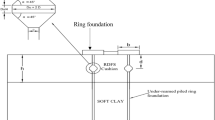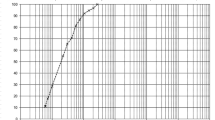Abstract
Calcareous sands form the foundation soils/structural fill for most of the engineering works in Kuwait, the Arabian Gulf countries and also act as structural fill. In situ calcareous sands are stronger than uncemented sand but lose much of their strength when re-worked or on wetting. The paper reports Dutch cone penetrometer tests on Jahra sand and Gatch under dry, wet and saturated conditions, using a specially designed sample box. The results showed that the penetration resistance (both tip and friction) of the uncemented sand increases upon wetting to an optimum with about a 70% increase from the dry, then decreases down to only 21% of the dry. With the calcareous sand, wetting was found to reduce the resistance in a directly proportional relationship, with a loss of resistance of 20% recorded at 7% water content and an 87% reduction when soaked. The friction ratio increased with increasing moisture content in uncemented sand but reduced to 50% in calcareous sands.
Résumé
Les sables calcaires constituent les sols de fondation ou les matériaux de remblai dans la plupart des travaux de génie civil au Koweït et dans les pays du Golfe arabique. La résistance des sables calcaires en place dépend de leur degré de cimentation. Ils perdent l’essentiel de leur résistance par remaniement ou humidification. L’article présente des essais au pénétromètre hollandais, réalisés sur des sables de Jahra et de Gatch, en conditions sèche, humide et saturée, utilisant une boîte d’échantillonnage spécifique. Les résultats ont montré que la résistance de pénétration (à la fois de pointe et de friction) des sables non cimentés augmente avec l’humidité jusqu’à une valeur supérieure de 70% à la valeur sèche, puis décroît jusqu’à une valeur représentant seulement 21% de la valeur sèche. Quant aux sables calcaires, l’humidification a pour effet de réduire la résistance de façon directement proportionnelle, avec une perte de résistance de 20% pour une teneur en eau de 7% et une perte de résistance de 87% pour un sable saturé. Le coefficient de friction augmente avec la teneur en eau pour les sables non cimentés mais diminue jusqu’à 50% pour les sables calcaires.













Similar content being viewed by others
References
Al-Sanad H, Shaqour FM, Hencher S, Lumsden A (1991) Geotechnical implications of subsurface water rise in Kuwait. Eng Geol J 31(1):59–69
Al-Sanad H, Shaqour FM (1990) The influence of changing groundwater levels on the geotechnical behaviour of desert sand. Q J Eng Geol 23:357–364
Begemann HKS (1953) Improved method of determining resistance to adhesion by sounding through a loose sleeve placed behind the cone. In: Proceedings of the 3rd international conference on soil mechanics and foundation engineering, ICSMFE, vol 1, August 16–27, Zurich, pp 213–217
Begemann HKS (1963) The use of the static penetrometer in Holland. N Z Eng 18(2):41
Begemann HKS (1965) The friction jacket cone as an aid in determining the soil profile. In: Proceedings of the 6th international conference on soil mechanics and foundation engineering, ICSMFE, vol 2, Monterio, September 8–15, pp 17–20
Blake WP (1902) The caliche of Southern Arizona, an examination of deposition by vadoze circulation. Trans Am Inst Min Met Eng 31:220–226
Brown CN (1956) The origin of caliche on the north eastern Liano Estacado, Texas. J Geol 64:1–15
Cooly ME (1961) Description and origin of caliche in the Gli-San Juan Canyon region, Utah and Arizona. Arizona Geol Soc Digest 4:35–41
Douglas BJ, Oslen RS (1981) Soil classification using electric cone penetrometer. In: American Society of Civil Engineers, ASCE, proceedings of conference on cone penetration testing and experience, St. Louis, October 26–30, pp 209–230
Eslami A, Fellenius BH (1996) Pile shaft capacity determined by piezocone (CPTu) data. In: Proceedings of 49th Canadian geotechnical conference, vol 2, September 21–25, St. John’s, Newfoundland, pp 859–867
Eslami A, Fellenius BH (1997) Pile capacity by direct CPT and CPTu methods applied to 102 case histories. Can Geotech J 34(6):880–898
Johnson DL (1967) Caliche on the Channel Islands. Mineral information service, Calif. Div. Mines and Geology, Vol.20, p. 151–158
Jones GA, Rust E (1982) Piezometer Penetration Testing, CUPT. Proceedings of the 2nd European symposium on penetration testing, ESOPT–2, Amsterdam, May 24–27, Vol.2, pp. 607–614
Netterberg F (1980) Geology of Southern African calcretes.: 1. Terminology, description, macrofeatures, and classification. Trans Geol. Soc S Afr 83:255–283
Netterberg F, Caiger JH (1983) A geotechnical classification of calcretes and other pedocretes, residual deposits—surface related weathering processes and materials. Blackwell/The Geological Society, London, pp 235–243
Owen RMS, Nasr SN (1958) Stratigraphy of Kuwait–Basra area. Habitat of oil, Symposium of the American Ass. Pet, Geologists, Tusla, Oklahoma, pp 1252–1278
Reeves CC (1976) Caliche: origin, classification, morphology and uses. Estacado Books, 233 p
Sanglerat G, Nhim TV, Sejourne M, Andina R (1974) Direct soil classification by static penetrometer with special friction sleeve. In: Proceedings of the 1st European symposium on penetration testing, ESOPT–1, vol 2.2, June 5–7, Stockholm, pp 337–344
Schmertmann JH (1978) Guide lines for cone test, performance, and design. Federal Highway Administration, Report FHWA-TS-78209, Washington 145 p
Senesset K Sandven R, Janbu N (1989) Evaluation of soil parameters from piezocone test. In-situ testing of soil properties for transportation, Transportation Research Record, No. 1235, Washington, pp 24–37
Shaqour FM (1990) Effects of groundwater level fluctuation on the engineering properties of desert soil. PhD Thesis, University of Leeds, 489 p
Shaqour F (1992) Hydro-behaviour of Middle Eastern desert soils. J Hydrol 138:41–52
Shaqour FM (2004) Hydro-compaction of sand fills. Elect J Geotech Eng (EJGE) vol 9, 0445, Bundle D
Sulaimi JS (1988) Calcrete and near surface geology of Kuwait City and suburbs, Kuwait, Arabian Gulf. Sediment Geol 54:331–345
Swedish State Railway Geotechnical Commission (1922) Staens Jarvagars Geoteckniska Kommission–Slutbetankande. Swedish State Railways (in Swedish with English Summary). Bulletin 2:228
Vos JD (1982) The practical use of CPT in soil profiling. In: Proceedings of the 2nd European symposium on penetration testing, ESOPT-2, vol 2, Amsterdam, May 24–27, pp 933–939
Author information
Authors and Affiliations
Corresponding author
Rights and permissions
About this article
Cite this article
Shaqour, F.M. Cone penetration resistance of calcareous sand. Bull Eng Geol Environ 66, 59–70 (2007). https://doi.org/10.1007/s10064-006-0061-2
Received:
Accepted:
Published:
Issue Date:
DOI: https://doi.org/10.1007/s10064-006-0061-2




